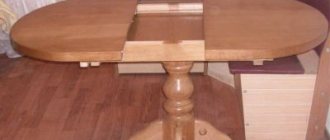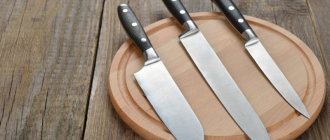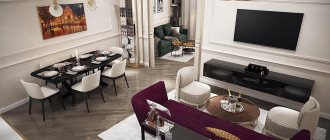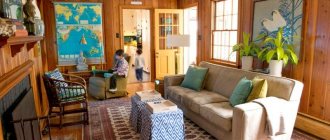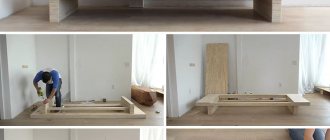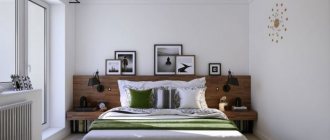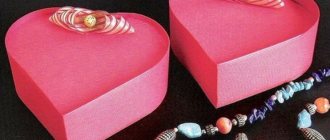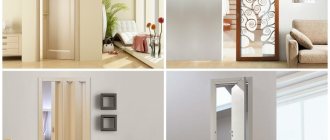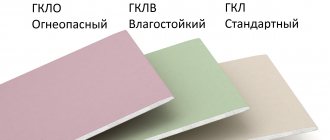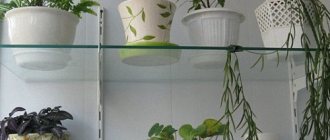How to choose the type of finish?
Not every type of decorative finish will look equally good in every room. For example, no one will wallpaper the bathroom. There are a number of criteria that you should focus on.
The material must be environmentally friendly and non-toxic. Make sure that it will not cause an allergic reaction in anyone in your household.
Can you handle applying it yourself or are you planning to use the services of workers? If you're on a budget, this could be a deciding factor.
Appearance is one of the most important parameters. In addition to matching your taste, consider some nuances. A light coating visually enlarges the room, while a dark one makes it smaller.
It is better to choose a calm, discreet palette for the bedroom, but in the nursery there is no place for gloomy shades. Photos of wall decoration will help you navigate.
The most important thing is the characteristics of the material itself. Its types differ in resistance to wear, moisture, temperature changes and mechanical stress. Everyone needs their own approach and care.
Here are some tips:
The kitchen, bathroom and toilet should be lined with moisture-resistant material that is easy to clean and inhibits the onset of mold.
The bedroom and children's room are finished with a breathable coating that does not accumulate dust.
Wear-resistant materials should be used in walk-through areas (hallway, living room, corridor).
Wallpapers and photo wallpapers
The wallpaper market offers a wide range of goods. Among the most popular are:
- Non-woven;
- Paper;
- Acrylic;
- Liquid;
- Textile;
- Metal;
- Vinyl;
- Glass wallpaper.
Paper and non-woven ones are among the simplest and cheapest. The former have been generally used for centuries, while the latter differ only in the addition of fabric fibers. Both types are used as a base for paint; they are environmentally friendly, have a wide range of colors, but are short-lived (cannot even be washed). The surface of such wallpaper is usually smooth, but there are options with a relief pattern. Acrylic and vinyl wallpapers are durable and resistant to moisture and ultraviolet radiation. The paper or non-woven base is covered with a special “foam”, which forms a durable top layer. The only downside is breathability; therefore, this material should not be used to glue walls in a child’s room. Textile wallpaper is made from a paper base and a second layer of natural fabric. The material looks very elegant, but it is expensive, fades, is easily damaged by moisture and quickly collects dust (they can even be vacuumed). In metal wallpaper, the top layer is made of thin aluminum foil. They look impressive, do not fade and are not afraid of water, but you will have to pay dearly for all these advantages. And finally, the last word in the world of wallpaper is liquid coating. It is sold in powder form and after application vaguely resembles decorative plaster. Liquid wallpaper contains cellulose fibers and glitter, which create a rich, elegant look.
Photo wallpapers are made from the same materials as regular ones. They represent a panorama from floor to ceiling. Images can be very diverse: from bright landscapes with “rich” colors to neutral abstract paintings with calm shades. Before gluing photo wallpaper, you need to clearly demarcate the finishing area so that later your design does not go into a corner or become askew. Paintings are purchased in special stores or made to order according to the selected design using special printing materials.
In a children's room, when choosing the type of wallpaper, focus on its environmental friendliness, and in the kitchen and bathroom you will have to choose a moisture-resistant material that can also withstand temperature changes.
Wallpaper
A timeless classic used in the vast majority of residential premises. In addition to their low cost and wide range of products, they are attractive because they can be glued without any special skills.
Wallpapers differ in structure (smooth, embossed or embossed), number of layers (one, two or more), material (paper, vinyl, non-woven fabric, textile).
Paper wallpaper can only be dry cleaned and cannot be used in rooms with high humidity.
Moisture-resistant ones will “survive” light wet cleaning, but for the kitchen or bathroom it is better to choose washable wallpaper - they can be fully washed with detergent.
Painting the walls
Decorative painting of walls is a worthy competitor to wallpaper, because it allows you to participate in the creation of a background canvas, rather than gluing a ready-made one. In addition, this method of decoration has a number of advantages:
- Paint will last longer than wallpaper.
- The surface will be solid without seams and joints, the formation of which cannot be avoided when using other materials.
- The paint will adhere to any base.
- To re-repair, you will not need to carry out complex manipulations over the old layer of paint, but the wallpaper will have to be scraped, moistened with water and again scraped off the most stubborn remnants tightly adhered to the glue.
- If you use special types of moisture-resistant paints, then this decoration can be done in the kitchen and bathroom.
Before painting directly, the wall is prepared. The remnants of the previous coating are removed from it and primed. Irregularities and recesses are puttied and sanded after drying. Then an additional layer of primer is applied and only after complete drying begin painting. When choosing a paint, they are guided by its composition and characteristic features that allow it to be used in certain rooms. The product range is classified into:
| Acrylic | They are environmentally friendly, lie on any surface, and after drying form a durable film that can withstand strong temperature fluctuations. |
| Water-based | They are considered “veterans” of the construction and repair market. Paints are inexpensive, dry quickly, allow moisture to pass through, but require special temperature conditions during the drying process and are washed off with water over time. |
| Latex | This modern type of paint can be diluted even with plain water. They are suitable for rooms with high humidity, are absolutely resistant to moisture, are odorless and dry quickly. The only downside is the rather high cost. |
| Oil and alkyd based paints | They fit well on the surface, but take a long time to dry, while emitting a sharp, unpleasant odor. They last a long time and are not washed off with water, but for the same reason they are expensive. |
There are a number of ways to apply paint. Regular paint rollers and brushes will lay it in an even, dense layer on drywall, plaster or concrete. A drawing or pattern is applied to the surface using a stencil, but this is the simplest option. A lot of more original methods have been developed, which require only available means. To get the effect of a “crumpled” canvas, simply wrap the roller with a piece of waste fabric, which is tied to the foam rubber with a coarse thread. The more folds it forms, the more original and interesting the pattern will be. A more sophisticated design will be achieved if you decide to create the illusion of Venetian plaster. This type of finishing was previously used exclusively for cladding facades, but over time it fit into the design of interior walls. For this method you will have to perform a number of actions:
- Take a can of latex paint and pour its contents into a wider container.
- Then pigment is spilled onto one half, which will darken the original color.
- It is carefully stirred so as not to touch the second part of the paint.
- With a simple spatula it is applied to the surface, like plaster. In this case, spots of dark and light tones alternate to create a beautiful picture of two shades, chaotically transforming into each other.
If it is difficult for you to work with one container for two different shades, then pour the paint into two different cans and work with them. These are just the simplest methods that exist. With the help of little tricks and patience, a simple wall can be transformed and decorated beyond recognition both outside and inside the house.
Using acrylic paint, a new surface can be artificially aged (stippling), which is perfect for rooms in retro or Provence styles. In the office they create the “businesslike” effect of expensive leather, for which you only need a homemade suede brush. Using sponges, pieces of fabric, bags, sponges and washcloths, designers create not only texture, but also relief.
Plaster
One of the most popular wall cladding options. This is not surprising, because plaster has a number of advantages: it is resistant to damage, easy to clean, durable and environmentally friendly.
Plastering walls can be done manually. The mixture can have different structure and degree of granularity. In addition, there are many simple techniques for applying it that allow you to achieve an interesting and unusual result.
Decorative painting
If you do not have artistic talent, you will have to contact a specialist to paint the walls in your apartment. This is delicate, painstaking work, which directly depends on the complexity of the chosen pattern. A room with painted walls will acquire an impressive flavor. The furnishings and furniture will have to match it. Three types of paints are used for artistic wall painting:
- Acrylic;
- Tempera;
- Oil.
Acrylic is durable and not afraid of moisture and temperature changes. Tempera is used to correct the smallest details, as the paint applies more gracefully. To obtain a relief pattern, it is applied to Venetian plaster. The paintings become voluminous and abstract with blurred features. Rooms were painted with oil back in the Middle Ages. Now the composition of oil paints has changed, and it is unlikely that your masterpiece will live as long as the ceiling of the Sistine Chapel, but we do not pretend to compete with the great masters of painting of the past. Recently, airbrushing has been considered a popular type of paint application. The can contains compressed powder or liquid dye that is sprayed over the surface. But such work requires special training: it is quite difficult to adapt to non-standard “writing” equipment. You can practice on any smooth surface that you don’t mind: a door from an unnecessary cabinet, an old mirror, a wall of a building to be demolished.
Panels
A kind of decorative boards used in interior wall decoration. The panels perfectly hide irregularities, wiring and other communications.
They are presented on the market in the form of sheets, rectangular sheets and slats. By searching, you can choose the ideal option that meets all your wishes.
Wall finishing with panels is done on top of the sheathing, both horizontally and vertically. The most popular panel materials are fiberboard, chipboard, and MDF.
Cork
Cork is obtained from the outer bark of certain types of trees. Most often it is obtained from the cork tree of the same name, which gave the name to the material. Due to the complex processing technology, the material is quite expensive, which is compensated by the durability and moisture resistance of the coating. Cork is available in two types:
- Rolls;
- Sheets.
Depending on the area of the wall they are going to cover with it, the type of material is chosen. Cork is pleasant to the touch: it is both strong and pliable. The material is resistant to mechanical damage. With a slight impact, it will simply bend and then return to its previous state, so it is quite difficult to scratch the cork coating. The downside is the color range, which is limited to all shades of brown.
Photos of wall decoration
Decorative panels
To install decorative wall panels, you will need a special design: metal or wood lathing. The components are “slung” onto it. Panels are classified into three types:
- Leafy;
- Tiled;
- Rack and pinion.
The second ones are much smaller, and it is easier to lay out an original drawing from them. Typically, tiles of different sizes and colors are used within the same range. Slatted ones vaguely resemble lining: long, narrow planks. Sheet panels are used to cover large areas. The materials used are plastic, glass, gypsum vinyl, wood and its derivatives (MDF, chipboard, fiberboard).
Wooden panels
Chipboard panels are made from chips that are hot pressed. The material is less durable compared to wood, and is susceptible to high humidity and temperature changes. It cannot be used for the bathroom or kitchen, so you will have to confine it to the living room, hallway or bedroom. Fiberboard is produced using the same technology, but instead of shavings, plant and wood fibers are used, which are more resistant to kitchen conditions, for example. However, this material should be protected from direct contact with water on the surface, so the bath remains taboo.
MDF is dry pressed, causing the chips to release lignin. It also forms a durable “film” that holds it together and improves performance. MDF is not afraid of water, ultraviolet radiation, or elevated temperatures. The material is also able to withstand heavy loads, so it is often used to create shelves. MDF panels are suitable for absolutely any room in an apartment or house. OSB boards are made from shavings, resins and synthetic wax. They have a rather unprepossessing appearance, which is compensated by their pleasant price and durability in all respects. The material in interior painting is used mainly for flooring, but this option is also suitable for walls.
Plastic panels
PVC has long established itself as a durable artificial material. Surprisingly, his formula was the result of an accident. The French scientist received it during an experiment and simply could not characterize his invention. PVC is made from polyvinyl chloride and a softener. The latter is added in minimal concentrations. PVC is actively used to create windows, window sills, doors and other products vital for residential premises. Plastic is fireproof, not afraid of water, temperature changes, it is easy to wash and difficult to scratch. PVC is relatively cheap and safe for health. The release of harmful substances is accompanied only by its production.
3D panels
Most of these three-dimensional, relief products are made from gypsum, although they can be made from MDF, bamboo, reed, plastic, glass, aluminum... In stores they will also kindly show you acrylic 3D panels, leather, porcelain stoneware, samples with built-in LED- backlight. What do all these variations have in common? In general, 3D panels are hypoallergenic and non-toxic, they attach quickly, and have good insulating qualities.
3D wall panels in the interior: types, selection, photos
A serious bonus is the ability to manufacture custom panels. A wide selection of samples allows you to fit this finish into any style: bamboo 3D panels will suit simple, emphatically eco-friendly interiors, 3D panels with a metallic sheen and futuristic pattern will highlight high-tech and techno, plain 3D panels will add zest to a neoclassical setting, and panels with a patina effect will harmoniously complement art deco and modern.
Among the disadvantages of this coating, consumers cite the ability of the panels to accumulate dust on a textured surface. And psychologists add: an excessive number of convex patterns will not only overload the interior, but can provoke irritability and poor health. Based on this, it is better to use 3D panels in fragments - on one wall, for example.
Top ↑
Walls
42 votes
+
Vote for!
—
Vote against!
Decorative wall decoration will help you create a unique designer design in your apartment. Today, many technologies have been developed that make it possible to approach this matter creatively. To make the interior design exclusive, they use ready-made prints and sketches for drawings in various techniques, decorative panels and mosaic inserts, mirror tiles and synthetic materials imitating wood and stone. The most interesting thing is wall decoration using homemade decorative panels. The self-taught decorator will come to the aid of ready-made ideas from famous designers, master classes by decorators and tips from technologists on decorating walls with modern materials.
Table of contents:
- Where to start in decorative wall decoration?
- The simplest wall decor - stencils
- Other decorating methods for those who cannot draw
- Textured and decorative plaster
- Decorative panels and mosaics made of broken tiles
- Wall decor with natural and “wild” stone and facing bricks
- Decorating walls with plastic and other synthetic materials
Where to start in decorative wall decoration?
You should not start a quality renovation if there is no stylistic solution, otherwise the money will be wasted. Before starting an interior renovation, it is worth considering not only the decision on individual decorative elements, but also deciding which interior style is preferable for renovation:
- Art Deco;
- modern;
- classic;
- avant-garde;
- high tech;
- techno;
- country;
- ecostyle;
- ethnicity;
- historical style.
It’s not difficult to create an original decorative finish for an external or internal wall without much effort. New building materials appear on the construction market every year, which are successfully used for original cladding in residential or non-residential premises. Previously, one could only dream of unusual materials and finishing technologies. Today, everyone has access to marble-effect tiles at the price of regular porcelain stoneware or veneered wallpaper with mosaic inserts in the marquetry style. For example, imitation wood in decorative wall decoration, photo:
Tip: To make a decision on wall decoration, it is important to consider:
- what the modern construction market offers;
- what are the latest trends in fashion for designer decoration and decoration of residential premises;
- what technologists and finishing craftsmen offer.
When using ready-made plastic panels with imitation of natural materials, it is easy to achieve maximum results at minimal cost. For those city residents who are not limited in funds for repairs, there is no need to decorate the walls with decorative panels or cut porcelain tiles for mosaic panels. Wealthy people trust only specialists with Venetian plaster or a multi-level ceiling with stained glass and LED lighting. An interesting effect can be achieved in another way - by experimenting with inexpensive materials and their combination.
The simplest wall decor - stencils
The use of original stencil designs is an excellent solution for those who do not know how to draw, but want to make exclusive decorative wall decoration, photo:
Sketches and silhouette drawings are easy to find, then these outlines are transferred to dense material. By holding the stencil or fixing it on the wall, it is easy to obtain the desired image of any color. Paints can be:
- spray with a spray gun or spray can;
- roll out with a roller with attachments;
- paint over with a wide paint brush or art brush.
Natural materials are also used to create a beautiful stencil design. For example, lightly rolling a roller over a large maple leaf can easily produce a naturalistic impression, including the veins. The contours are outlined by spot spraying paint of a different color. And the maple leaf itself can be impregnated with paints of different colors to get colored leaves.
Using a simple example, it is easy to see that it is very easy to make original decor yourself, without the talent of an artist. It is enough to have desire, good taste and creative inclinations. This method is suitable for different techniques:
- shadow silhouettes;
- recognizable two-color images (Tsoi, Che Guevara, Marilyn Monroe and other cult personalities);
- color template contrasts.
Tip: Use crumpled foil, a coarse sponge, faux fur, and different roller attachments with expressive textures to achieve an interesting effect. In this case, the paint in the stencil gap is applied in fragments.
Other decorating methods for those who cannot draw
There are many techniques to get an interesting drawing without the skills of an artist. For example, together with your child it’s easy to make a fairy-tale tree on the wall for decorative decoration of interior walls.
1. It’s easy to cut out the silhouette of a tree trunk with a hollow and branches from colored paper or cardboard. And it is proposed to draw the leaves using prints of children's palms dipped in gouache. These improvised leaves are then corrected with a brush. And in the hollow you can “plant” an owl printed on a printer. The fairytale tree can easily be supplemented with other birds.
2. For finished images, use the appliqué or collage method, when a small image or a whole panel is laid out from several fragments.
3. Ready-made puzzles are also suitable - the upper part of the picture is folded and pasted on the wall, and the lower part or corner seems to crumble and blow away in the wind.
4. Vinyl stickers, which were purchased at the nearest stationery store, will help you get a finished drawing on the wall. They also decorate furniture and other interior items. The only wish is that the theme of the stickers should match both the style and seasonality.
5. Using volumetric applique from:
- paper;
- thin plastic;
- polystyrene foam;
- cotton wool;
- dry plants, spikelets and other natural materials.
6. Classic decorative wall decoration photos - in frames, in the form of collages or an entire installation. Designers have proposed many original methods for decorating walls with photographic images, including printing enlarged images with industrial prints.
The only drawback is that after some time these elements will have to be replaced, since dust accumulates on them.
Tip: If you are not confident in your ability to decorate walls yourself, first experiment with applique on any other smooth surface. The fragments can be easily secured to the door with double-sided tape to evaluate the results. If it turns out beautifully, transfer the decor to the wall and secure it firmly.
Some people like to change the decor of their room frequently, for example, depending on the season. Then you should not mount the elements on the wall. Then the tree drawn in the children’s room will be able to “grow” with a new “robe” every 3 months:
- young spring leaves with flowers;
- large leaves with summer fruits;
- colorful autumn foliage;
- snowflakes or “cotton” frost.
Attention: An interesting effect can be achieved if the wall is decorated not only with single images, but also with repeating ones. For example, flying butterflies or birds, leaves or snowflakes.
Textured and decorative plaster
Another way to decorate the walls in an apartment is to decorate the walls with decorative plaster. The construction market has many interesting offers for original wall decoration. The method is also good because it solves several problems at once:
- we do repairs;
- getting rid of wall defects;
- updating the design of the apartment;
- decorate the walls.
Tip: This is the final cladding of walls over a prepared surface. But you should not choose this method if the wall being treated often gets dirty. The cellular texture quickly becomes clogged with dust, kitchen fumes and other contaminants.
Not every technology for applying decorative plaster is easy to master for the first time, for example, layer-by-layer “Venetian”, which only a professional can handle. Simpler varieties are obtained “by themselves”, thanks to the special chemical composition and original methods of obtaining a volumetric texture. We suggest watching a video on the technique of working with decorative plaster, which is located at the end of the article.
Decorative panels and mosaics made of broken tiles
An excellent decorative material for wall decoration is ceramic tiles and porcelain stoneware, especially imported ones. For original panels use:
- mosaic soft tiles;
- porcelain tiles imitating marble and gems;
- elite imported tiles;
- cameos and other three-dimensional drawings;
- special decorative inserts;
- broken ceramic tiles for mosaic panels.
Decorative inserts and rosettes are sold in finished form, where a print or relief design is applied to one or more tiles. Looks impressive on a solid wall lined with uniform tiles or porcelain stoneware. Suitable for decorative finishing of walls in residential and non-residential premises. For the bathroom, functional fragments are produced, that is, tiles with a towel hook or soap stand.
A picturesque panel is often used to decorate a wall in an apartment. It can be small in size or occupy the entire wall in the bathroom, hallway or bedroom. It looks beautiful when the theme of the decor has something in common on the floor, walls, ceiling and furniture. For example, picturesque paintings with Japanese cherry blossoms in bloom echo the “open sky” of the stretch ceiling, complementing the exoticism of the country with a mosaic pattern of a geisha on the floor.
To ensure that the decorative canvas fills the entire wall of a large room, special frieze panels are produced, with the main element in the center. Next, the image is complemented by tiles in all directions with or without a specific pattern.
The relief tile panel is not inferior in beauty to the decorative decoration of walls with wallpaper with a 3D effect. Sometimes the volume is so realistic that you want to go down these steps onto a Parisian street or into the forest right from the hallway or kitchen!
These are ready-made images, but making a panel from broken tiles with your own hands is a fascinating process, an opportunity to show your imagination. There are a lot of similar sketches, so you don’t have to figure out where to put them:
- fragments of ceramic tiles;
- porcelain stoneware trimmings;
- ornamental stone;
- fragments of broken colored glass and mirror tiles.
Wall decor with natural and “wild” stone and facing bricks
Original wall decoration with decorative bricks and bare masonry has been used for a long time. In some interior styles this is the main facing material:
- urbanism;
- brutalism;
- techno;
- high tech;
- avant-garde;
- disco;
- minimalism, etc.
Decorative natural stone is the oldest wall cladding known to mankind. But today the synthetic analogue and “soft stone” are most widespread. Some types of such wall decoration are easy to make yourself - based on gypsum or cement mixture, with the addition of pigment and texture inclusions. But the most impressive finishes involve natural materials:
- colored sandstone;
- shell rock;
- marble and granite;
- slate, etc.
Inserts made from cut ornamental stones look very beautiful:
- jasper;
- agate;
- malachite;
- sardonyx;
- chalcedony;
- cornelian;
- milky amber, etc.
Colored marble is an indispensable finishing material, but it is very expensive and is considered an elite cladding. That is why it is proposed to replace it with harder and cheaper porcelain stoneware with a similar texture and pattern. Today it is possible to obtain the most picturesque analogues of rare varieties of marble, the reserves of which, unfortunately, have almost been depleted in most deposits. Now decorating walls with decorative stone of natural origin is becoming a thing of the past, and it is being successfully replaced with a synthetic analogue.
The crystalline texture of natural stone looks great in good lighting, while porcelain tiles fade in artificial light. Decorating walls with artificial analogues is duller, but accessible to most city dwellers.
Decorating walls with plastic and other synthetic materials
Affordable price tags and ease of installation are the main reasons for the displacement of natural materials by artificial analogues. The most commonly used wall cladding is:
- natural wood and its replacement;
- mirror and plastic panels;
- non-woven wallpaper for painting with a voluminous decorative pattern or jacquard fiberglass;
- original rolls with a texture imitating fabric, suede and leather.
Decorative panels made of plastic with imitation of natural materials are affordable, easy to install, clean or wash. Laminated “wood-like” plastic looks good, and it cannot always be distinguished from wood. It harmonizes perfectly with natural parquet and woodwork.
Finished wall panels are mounted on the prepared surface. This finish simultaneously serves as decoration and insulation, and also hides some wall defects. From fragments of cut plastic panels you can also lay out panels and mosaics on any theme.
PVC panels
Finishing with PVC panels will cost 30-40% less than with ceramic tiles. In addition to being cheap, PVC panels are practical, easy to use, and insensitive to temperature changes. Installation of the panels is also quite simple. Contrary to rumors, PVC does not emit toxic substances and is considered a safe finishing agent. You don’t have to worry about the appearance of the panels, and they come in different colors, for 8-10 years.
Among the disadvantages of PVC finishing are its lower strength compared to ceramics, toxicity when burning, and also, oddly enough, cheapness: for many this is an indicator of lack of prestige.
Top ↑
Types of decorative wall decoration in the interior of the house
After drawing up an estimate, select the color and finishing patterns. It is recommended that styles, wall design ideas, and decoration of different rooms be in harmony with each other. The ideas shown in the selection of pictures will help you to beautifully and inexpensively repair the walls in your house or apartment. Tips and examples of using different materials in photos will help you with ideas and solutions.
interiors of apartments and rooms photosFinishing requirements, nuances of choice
Select the design of the apartment according to the operational requirements of the room for which they are intended. For example, interior decoration and the design of bathtub walls require moisture-resistant options, and washable wallpaper for the hallway. For the working kitchen area, take durable ceramic tiles, waterproof paint, glass and plastic panels.
Choose sources for interior decoration of the house, taking into account the following factors:
- finishing materials for walls are environmentally friendly and non-allergenic;
- meet the requirements of industrial safety regulations;
- durable;
- easy to install;
- have a beautiful view.
The supply of building materials on the market is huge, however, the decoration of the walls in the apartment (the options are varied) is provided by a large selection of paint, wood trim, decorative plaster, wallpaper, a variety of tiles, and artificial stone.
Decorative plaster
This general term refers to a layer of construction and decorative mixture applied to the surface of the walls. It levels the walls, insulates them, insulates them, and is also, of course, one of the most ancient methods of beautifying a home inside and out.
Plaster mixtures can be divided according to two criteria - according to the composition of the mixture and according to artistic qualities.
Mineral plaster
Mineral plaster is the most economical type of plaster. This is due to the base of the mixture - cement, which is “seasoned” with chemical additives that provide increased moisture resistance. To this we can add environmental safety, vapor permeability, resistance to fungi and mold, temperature changes, as well as fire safety.
Among the disadvantages are the not very diverse color palette and the complexity of application. But the average period of operation of a mineral coating does not exceed 15 years.
In addition to mineral, there is also: silicate, based on liquid glass; silicone, which is based on silicone resins; polymer - with acrylic resin in the composition. Silicone and mineral plasters have the longest service life.
Top ↑
Textured plaster
[ads_block] Textured (structural) decorative plaster is a way of decorating walls that can be called an unfading classic. Due to the fact that the plaster mixture contains various additives (pebbles, fibers, marble chips or ground bricks), this finish can look like rock, valuable wood, cork bark, sand patterns, cracked clay, dug velvet. Textured types of plaster include the famous “fur coat”, as well as bark beetle plaster, a method of finishing halls and hallways that has been popular for many decades.
Textured plaster is an excellent solution for those who want to get a unique interior. It will definitely provide picturesqueness and sophistication. And at the same time, strength, durability, and fire resistance. Plaster will help hide small defects on the walls, and its price is not bad at all. Textured plaster will not put to shame any of the palace, classical interior styles; it will be a good find for the hall, living room, and dining room.
Judging by the reviews, this design has one drawback - it is difficult to remove when the need for new repairs arises. The time during which textured plaster will not lose its attractiveness is 15-20 years.
Top ↑
Venetian plaster
It's hard to believe that this type of coating is over 500 years old. “Venetian” creates the impression of a noble stone - marble, granite, onyx, jasper, opal, malachite, amber. Such a sophisticated type of decoration literally asks for the walls of spacious living rooms, where there are fireplaces, hanging canvases in lush frames and the spirit of the Renaissance is in the air. Venetian plaster is unique: there are no two identical copies of it in the world! It is precisely this that can be seen inside the palaces of the Venetian doges and the villas of Italian aristocrats. “Venetian” is not only enchantingly beautiful, but also safe, moisture-resistant, durable and capable of pleasing the eye not for years, but for centuries! But the price also matches it.
Top ↑

